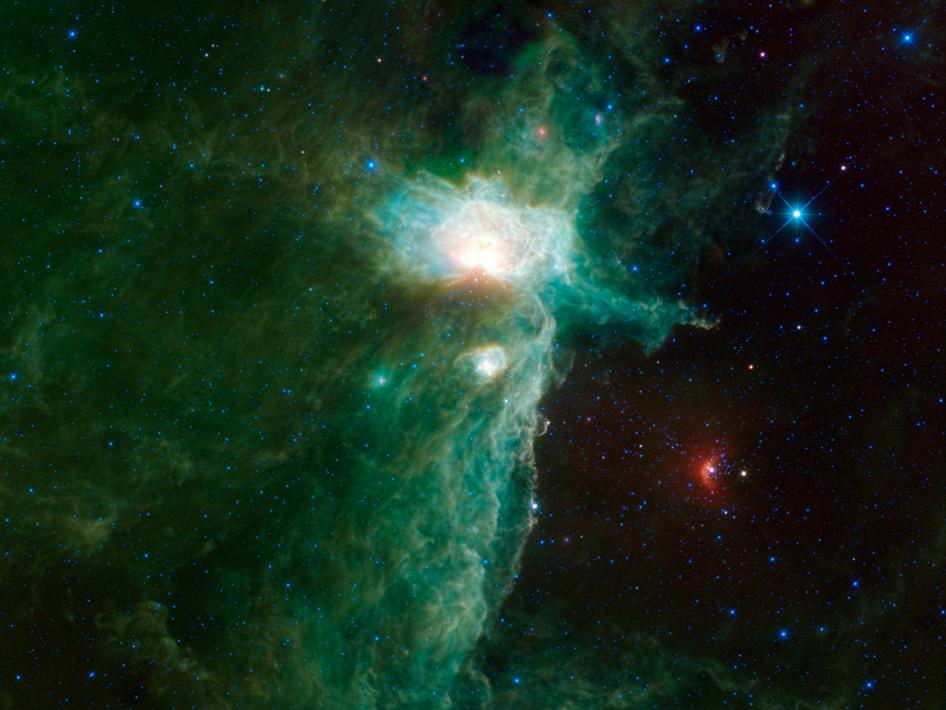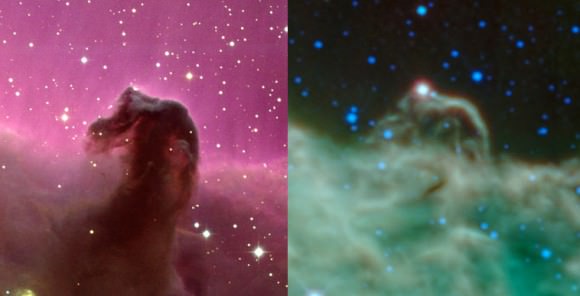A vast star-forming cloud of gas and dust in the constellation Orion shines brightly in this image from NASA’s WISE space telescope, where infrared light is represented in visible wavelengths. It’s part of a recent data release from WISE, a trove of infrared images acquired during the telescope’s second sky scan from August to September of 2010 — just as it began to run out of its essential cryogenic coolant.
Shining brightly in infrared radiation, the Flame nebula (NGC 2024) is at the heart of the cloud. Just below it is the reflection nebula NGC 2023, and the small, bright loop protruding from the edge of the gas and dust cloud just to its lower right is the Horsehead nebula — whose famous equine profile appears quite different in infrared light than it does in visible.
The two bright blue stars at the upper right portion of the image are both stars in Orion’s belt. Alnitak, the brighter one closer to the Flame nebula, is a multiple star system located 736 light-years away whose stellar wind is responsible for ionizing the Flame nebula and causing it to shine in infrared. Alnilam, the dimmer star at the uppermost corner, is a blue supergiant 24 times the radius of our Sun and 275,000 times as bright, but 1,980 light-years distant.
The red arc at lower right is the bow shock of Sigma Orionis, a multiple-star system that’s hurtling through space at a speed of 5,260,000 mph (2,400 kilometers per second). As its stellar wind impacts the interstellar medium and piles up before it, an arc of infrared-bright radiation is emitted.
Sigma Orionis is also the star responsible for the glow of the Horsehead nebula.
 This rich astronomical scene is an expanded view from WISE’s previously-released image of the region (at right) which used data from only three of its four infrared detectors. In contrast, all four detectors were used in the image above, making more of the nebulae’s intricate structures visible as well as providing comparative information for researchers.
This rich astronomical scene is an expanded view from WISE’s previously-released image of the region (at right) which used data from only three of its four infrared detectors. In contrast, all four detectors were used in the image above, making more of the nebulae’s intricate structures visible as well as providing comparative information for researchers.
“If you’re an astronomer, then you’ll probably be in hog heaven when it comes to infrared data,” said Edward (Ned) Wright of UCLA, the principal investigator of the WISE mission. “Data from the second sky scan are useful for studying stars that vary or move over time, and for improving and checking data from the first scan.”
Read more on the NASA news release here.
Top and right images: NASA/JPL-Caltech/WISE team. Horsehead nebula visible light image was taken with the 0.9-meter telescope at Kitt Peak National Observatory. Photo credit & copyright: Nigel Sharp (NOAO), KPNO, AURA, NSF. Comparison by J. Major/Universe Today.



Is it just me or does anybody else, whenever they see the Horsehead nebula, think of the horse’s head scene in The Godfather movie?
It’s a nebula you can’t refuse.
Mr. Hands, anyone? 😀
It looks like phoenix spreading its magical wing! (1st picture)
Orion is by far my favorite constellation, he was the one I learned first when I was like 5 or 6 years old and much later the first one I got to practice with my telescope.